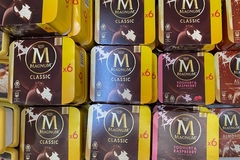
- Industry news
Industry news
- Category news
Category news
- Reports
- Key trends
- Multimedia
- Journal
- Events
- Suppliers
- Home
- Industry news
Industry news
- Category news
Category news
- Reports
- Key trends
- Multimedia
- Events
- Suppliers
Color me natural: Exberry executive underscores growing consumer appetite for “food from food”

10 Oct 2019 --- Artificial food colorings remain under heavy scrutiny by label-conscious consumers, which propels brands such as GNT’s Exberry range of natural “Coloring Foods” into the spotlight. Comprising minimally processed food grade pigments sourced from freshly harvested crops, Exberry responds to the coloring needs of broad food and beverage applications. At the GNT headquarters in Mierlo, the Netherlands, FoodIngredientsFirst speaks to Exberry Managing Director Frederik Hoeck on the growing consumer appetite for “food from food,” which is quickly becoming ubiquitous across global markets.
“Our raw material is food and Exberry – our product – is also food,” says Hoeck. “A significant differentiator of natural colors is that you would never eat a spoonful of artificial colors. This is possible with Exberry.”

Frederik Hoeck at the GNT headquarters in Mierlo, the Netherlands.Exberry Coloring Foods are marketed by GNT as delivering on appearance, performance and clean label appeal. The colors are obtained from fruits, vegetables and other edible plants. They are made using gentle, physical processes such as pressing, chopping, filtering and concentrating, with no chemical solvents. Exberry pigments are available in both liquid and powder formats.
“This is a big advantage to our customers, especially in Europe, where there is a demand for labels that indicate food coloring made with pumpkins, orange and black carrots and radishes, for example. Consumers are familiar with these ingredients and can understand where they come from,” adds Hoeck.
On average, 8,000 metric tons of Exberry Coloring Foods are produced annually. Hoeck highlights that this amounts to approximately 35 billion servings of food and drink. “This is probably not a lot when you compare it to sugar or apple juice concentrates, but in the area of color this is quite a significant amount. GNT has the widest portfolio in the area of coloring food with food,” says Hoeck.
Available in more than 400 shades, Exberry Coloring Foods are sold globally. They are Halal compliant, Kosher parve approved and suitable for vegetarians and vegans. Organic versions have also been made available by the manufacturer.
Formulating with spirulina Blue spirulina by Exberry.
At the GNT facilities in Mierlo, Hoeck showcased Exberry’s production line of high-intensity blue spirulina food coloring. In a recent investment program, the company doubled its spirulina processing capacity, solidifying Exberry’s position in the market for blue coloring foods, which have traditionally been notoriously difficult to produce.
The spirulina-based color powders allow food and beverage manufacturers to formulate products with high-intensity blues from a natural and traceable source – and at reduced doses. They offer superior solubility and stability in a number of applications and are particularly suitable for incorporation into instant beverages, hard-panned products, fondant, white chocolate and pressed tablets.
Within the expanding space for clean label alternatives to synthetic dyes, spirulina is currently seeing ample market share as the fastest growing botanical ingredient, largely due to its properties as a natural coloring agent and health benefits. The extract has proliferated across markets with 63 percent average annual growth (Global, CAGR 2014-2018).
Black carrots used as raw material for Exberry products.Developing markets for natural colors
“In the global market for natural food colors, Europe is a frontrunner, with the US market closely following. Asia is more fragmented,” Hoeck explains. “The Southeast Asian countries of Thailand and Vietnam are already quite advanced in their demand, while the Chinese market is also quickly growing.”
GNT will soon be showcasing its Exberry Coloring Foods range to the Middle Eastern market at the upcoming Gulfood Manufacturing 2019 (October 29 to 31). Santhosh Thankappan, Sales Director at GNT Middle East, says, “Consumers in the Gulf region are becoming more curious about how food and beverage products are manufactured. In turn, scrutiny of product labels and ingredients lists is intensifying.”
“In a growing market more and more providers of colors are entering the Coloring Foods market. With Exberry we have been 100 percent dedicated to this market of Coloring Foods for over 40 years,” explains Hoeck.
Last month, US brand KIND healthy snacks discontinued its Fruit Bites line from retail in a bid to draw attention to the “unnecessary use” of synthetic dyes in a wide variety of foods consumed by children. The move came just two years after the products were brought to market.
Natural botanicals have been pegged by industry as a clean label alternative to synthetic dyes, within this space, spirulina is currently seeing ample market share as the fastest growing botanical ingredient, largely due to its properties as a natural coloring agent and health benefits. The extract has proliferated across markets with 63 percent average annual growth (Global, CAGR 2014-2018).
GNT prioritizes long-term relationships with its farmers.Circular color production
GNT’s approach is to establish long-term relationships with farmers to deliver the raw materials needed to make Exberry Coloring Foods. These growers produce crop varieties from seeds developed by GNT’s own agronomists in order to deliver the exact color shade required.
The company’s agronomists play a key role in helping manage relationships with the company’s growers by maintaining a constant dialogue. “It is a vertical approach that gives the company full control over its supply chain so it can deliver color consistency and security of supply,” notes Hoeck.
“We give seeds to the farmers and they sell their products back to us on a long-term basis. Establishing a mutual trust with our farmers is important to us. We purchase the entirety of our crops back from our farmers at a set price, which ensures price stability for our end consumers,” says Hoeck.
As many as 80 percent of the vegetables, fruits and edible plants used to make Exberry Coloring Foods are cultivated in an area close to the company’s production plant in Heinsberg, Germany. The proximity of the fields to the factory ensures raw materials arrive when they are still fresh. At this point they are processed immediately or put into frozen storage for later use, guaranteeing they will deliver optimized color quality.
From Heinsberg, the semi-finished concentrates are transported to GNT’s factory in Mierlo, where they are blended and further processed into finished ingredients ready for use in food and beverage products. Mierlo is also home to GNT’s extensive quality control laboratory.
As no synthetic chemicals are utilized in production of Coloring Foods, the Exberry production chain exhibits no risk of expelling chemical pollutants that enter. After processing, the organic waste output is used as livestock feed. Ninety-five percent of all raw material residues are utilized for feed (GMP+ certified) or biogas production.
“We are almost a zero-waste company because the waste we produce is animal food. For example, when extracting the colors from carrots, we are left with the residual fibers that we leave with farmers to feed their livestock,” notes Hoeck.
“Colors should be viewed positively. We are able to tell a story in a positive and transparent way because our colors come from nature. Nature has so much to give,” he concludes.
By Benjamin Ferrer










